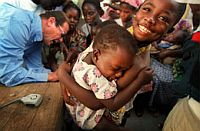Thalif Deen
UNITED NATIONS, Jan 22 2008 (IPS) – The sharp decline in deaths among infants and children worldwide during the past century is one of the great success stories in international public health , the U.N. children #39s agency UNICEF said Tuesday.

UNICEF Goodwill Ambassador Roger Moore assists with polio immunisation in Elmina, Cape Coast, Ghana. Credit: UNICEF
The annual number of child deaths has been halved, from roughly 20 million in 1960 to 9.7 million in 2006.
But a closer look at these trends reveals that progress has been unevenly distributed, says the annual State of the World #39s Children 2008 , released by UNICEF.
There is no room for complacency, warns UNICEF executive director Ann Veneman. The loss of 9.7 million young lives each year is unacceptable.
And despite progress, she said, the world is not yet on track to achieve the Millennium Development Goal (MDG) target of a two-thirds reduction in the rate of child mortality by the year 2015.
Of the 62 countries making no progress or insufficient progress towards the MDG on child survival, nearly 75 percent are in Africa.
Related IPS Articles
And of the 46 countries in sub-Saharan Africa, only three are on track to meet the MDG goal: Cape Verde, Eritrea and Seychelles.
In Southern Africa, infant and under-five mortality have increased, as AIDS reduces life expectancy and increases mortality from infections, tuberculosis, malaria and under-nutrition, the UNICEF report said.
And maternal mortality remains unacceptably high both in Africa and South Asia, with little advances over the past decades.
On average, UNICEF said, more than 27,000 children under the age of five die each day, most of them from preventable causes. But over 80 percent of all under-five deaths in 2006 were in sub-Saharan Africa and South Asia.
What is a life worth? asks UNICEF. Most of us would sacrifice a great deal to save a single child. Yet somehow on a global scale, our priorities have come blurred.
Nearly all of the 27,000 children who die each day live in the developing world. And more than one-third of these children die during the first month of life, usually at home and without access to essential health services and basic commodities that might save their lives.
The major causes of death for children under five are: neonatal causes (36 percent); pneumonia (19 percent); diarrhoea (17 percent); malaria (8.0 percent); measles (4.0 percent) and AIDS (3.0 percent).
Of the 11 countries where 20 percent or more of children die before the age of five Afghanistan, Angola, Burkina Faso, Chad, Democratic Republic of Congo, Equatorial Guinea, Guinea-Bissau, Liberia, Mali, Niger and Sierra Leone over half have suffered a major armed conflict since 1989.
Similarly, says the UNICEF report, fragile states characterised by weak institutions and high levels of corruption, political instability and a shaky rule of law are often incapable of providing basic services to their citizens.
Institutional and environmental factors can sometimes be the dominant factor in child survival, the study notes.
In countries where AIDS has reached epidemic levels, for example, combating the syndrome is the main challenge for child survival, it says.
The scale and nature of the AIDS epidemic is such that all other interventions will prove ineffective unless the deadly disease is addressed first.
The report also says that countries that suffer from food insecurity, or are prone to droughts, are also at risk of having poorer child survival outcomes. The inability to diversify diets leads to chronic malnutrition for children, increasing their vulnerability to ill health and ultimately, death.
Dr. Margaret Chan, director-general of the Geneva-based World Health Organisation (WHO), says stepping up investment in health systems will be crucial if we are to meet the child health targets set by the United Nations.
But still progress can be made even when health systems are weak, she argues.
Innovative programmes in many countries show that an integrated approach where each child is reached with a package of interventions at one time can bring immediate benefits, she adds.
Veneman points out that lives can be saved when children have access to community-based health services, backed by a strong referral system.
According to Veneman, widespread adoption of basic health interventions, including early and exclusive breastfeeding, immunisation, vitamin A supplementation and the use of insecticide-treated mosquito nets to prevent malaria, are essential in scaling up progress, particularly in Sub-Saharan Africa and elsewhere.
Our challenge now is to act with a collective sense of urgency to scale up that which has proven successful, Veneman declared.